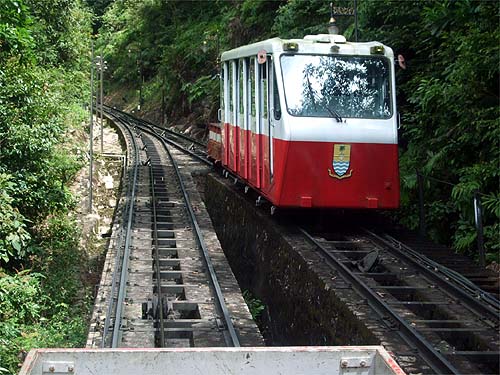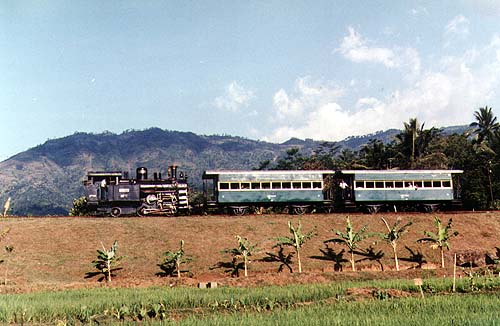|
Some of the biggest challenges faced by railway builders
through the years have been presented by hills and mountains. Splitting
trains, multiple
locomotives, tunnels, curves, even horseshoes and spirals are all
commonplace in my book, sometimes it needs something a little more
interesting... For some general coverage in Wikipedia, see a
short list of relevant articles at the bottom of this page to get
started there. These pages instead highlights outstanding currently open (and
relatively recently closed) examples especially
outside Europe and North America, particularly where reports exist on this
website.
By and large there are three solutions for when the problem
gets really serious,
each one reflecting a more extreme need to climb, these are covered in these
pages:
I would like to thank James Waite for not only suggesting
the creation of these pages but also doing a lot of the spade work both in the
field and virtually. I would welcome further pictures to illustrate them.
Compared to railways with reverses and
rack sections, this is a mammoth subject and certainly not an area I want to
compete with other enthusiasts who have an established presence on the web.
However, these naturally concentrate on passenger carrying 'funiculars'
particularly in Europe.
Recent additions:
Great Orme Tramway (5th May 2015)
Trenak, Examples of funiculars
through Europe (24th October 2013)
Mark How's Briitish Funicular and Cable
Railways (20th February 2010)
Bruse's funiculars (20th February
2010)
Thomas Kautzor's funiculars (16th
December 2009)
Old incline at Naruja, Romania (16th
December 2009)
Funiculars
Michel Azéma has done for funiculars what I have tried
to do for steam power with his excellent Funimag pages:
Introduction - http://www.funimag.com/index.htm Technical
Information - http://www.funimag.com/Funimag-PermanentSections.htm (link
dead by April 2015) Specific
Articles - http://www.funimag.com/Funimag-oldissues.htm
Mark Hows specialises in UK systems
(20th February 2010):
British Funiculars (including cable winders for
industrial systems - http://www.hows.org.uk/personal/rail/index.htm (Link broken by December 2021)
Bruse's funiculars - international
(20th February 2010):
http://www.funiculars.net
Trenak, a Basque based website with
examples of funiculars through Europe (24th October 2013)
http://www.trenak.com/expo-trains-funiculars/
(domain dead by October 2017)
These Wikipedia links will provide more guidance for
real and virtual travellers:
Wikipedia - http://en.wikipedia.org/wiki/Funicular Wikipedia
- http://en.wikipedia.org/wiki/List_of_funicular_railways
Beware! The Wikipedia list is less and less
comprehensive the further one travels from Europe...
Some of the following Funimag links were
dead by April 2015.
The Americas:
List of major funiculars in South America -
http://www.ferrolatino.ch/FLBStandseilLatAmEng.htm List of
other funiculars in South America - http://www.ferrolatino.ch/FLBStandseilLatAmWeitereEng.htm Most
of this is North America (boring!) - http://www.funimag.com/Funimag-Links-America.php
Africa - not much but...
http://www.funimag.com/photoblog/index.php/categorie/africa/
Asia:
http://www.funimag.com/Funimag-Links-Asia.php
Middle East (yes the link is correct!)
http://www.funimag.com/Funimag-Links-Africa.php
Australasia
http://www.funimag.com/Funimag-Links-Oceania.php
Rob's Funiculars:
Great
Orme Tramway (5th May 2015)
Penang Hill Railway, Malaysia 2009
report (red), 2010 report
and 2012 report (blue).

Hong Kong Peak Tramway
James Waite's Funiculars
Hungary
Castle Hill Funicular Budapest
United Kingdom
Lynton and Lynmouth Cliff Railway
Switzerland (added
30th August 2011)
The Le Châtelard funicular
Thomas Kautzor's Funiculars
China (added
16th December 2009)
Qianwei temple funicular
Philippines
(added 16th December 2009)
Tagaytay(?) casino funicular
Other Cable Railways
If you were to read the following article below, you
might think you were reading about ancient history, whoever wrote the
article and its subsequent editors must all have led a very sheltered
background.
Wikipedia - http://en.wikipedia.org/wiki/Cable_railway
UK Cable Railways
See Mark How's site on British Funiculars which also
covers this (20th February 2010)
http://www.hows.org.uk/personal/rail/index.htm
Rob's Industrial Cable Railways - this is
a totally under-reported area, please email me your
contributions!
My choices include cable railways which are nothing to do
with hills, they are a valid solution to situations on the flat too!
China
They are everywhere here even well into the 21st
century.
600mm gauge coal tramways round Nanpiao, December 2003
(part) - ../china/trains/china219.htm
Narrow gauge extras in China, 2003 - 2009 - ../china/trains/china288.htm

Long March to Ma Miao, 2009 - ../china/trains/china274.htm
India
Cable Railways at Tipong Colliery, India, 2008
Indonesia
There's nothing much flatter than the delivery yard of a sugar mill in Java,
but where loaded cane wagons ('lori' locally) have to be moved a short
distance from time to time, an old fashioned steam winch (this is Olean
mill) is the perfect answer although most mills would use an electric motor
these days:
Romania
The Covasna - Comandâu forestry railway had an inclined plane, which is
part of a current preservation scheme. I visited it in 1998, just before
normal working ceased and you can read my report.

Hans Hufnagel tells me (16th December 2009) that there
are pictures of four other inclines covered in his Walder und Dampf book
Part 2 - Gainesti (page 77), Busteni (page 108) and Curtea de Arges (page 115).
Also there were many more in the former Austro-Hungarian empire, but all are
history. This is a historical picture of the incline at Naruja:

United Kingdom
I do not have much current information but quite recently, there were small
scale coal mines in the Forest of Dean using cable haulage on narrow gauge
railways. Hopewell is best described as a 'working museum'. Freemining is an
ancient right being based on birth within the traditional area of the FoD,
something which is behind opposition to attempts to close the remaining
maternity facilities in the area. See:
http://www.minersadvice.co.uk/free_miners_forest_of_dean.htm
http://www.fweb.org.uk/dean/deanhist/miners.htm (Link broken
by 1st November 2018)
See for example these pages:
http://www.ingr.co.uk/news_2007.html
http://www.minersadvice.co.uk/monument_pit.htm
http://www.minersadvice.co.uk/phoenix_hopewell.htm
http://www.aditnow.co.uk/mines/Monument-Coal-Colliery/
http://www.aditnow.co.uk/mines/Hopewell-Colliery-Coal-Mine/
http://www.fweb.org.uk/dean/visitor/places/placewest.html
- gives Hopewell location and opening hours (Link broken by 1st November
2018)
James Waite's Industrial Cable Railways
Brazil
The Piacaguera - Paranapiacaba Incline at Work
United Kingdom
Some historic inclines
As always Wikipedia is some help
in a specialist subject but when 'push comes to shove' you soon find gaps in
the coverage, not to mention things which are downright wrong... Worse
still are the 'Look Alike' sites which lift material from Wikipedia in a bid
to make money from advertisements and thereby foul up the search engines.
Some useful
links are:
Hill Railways in General - http://en.wikipedia.org/wiki/Hillclimbing_(railway)
(link corrected 26th April 2014)
Mountain Railways - http://en.wikipedia.org/wiki/Mountain_railway
Rack Railways - http://en.wikipedia.org/wiki/Rack_railway and
http://de.wikipedia.org/wiki/Zahnradbahn#Liste_der_Zahnradbahnen
- look for conflicts!
Reverses - http://en.wikipedia.org/wiki/Zig_zag_(railway)
Funiculars - http://en.wikipedia.org/wiki/Funicular
There are many sub-links within these pages, some to
specialist technical information, others to items on individual railways.
|












